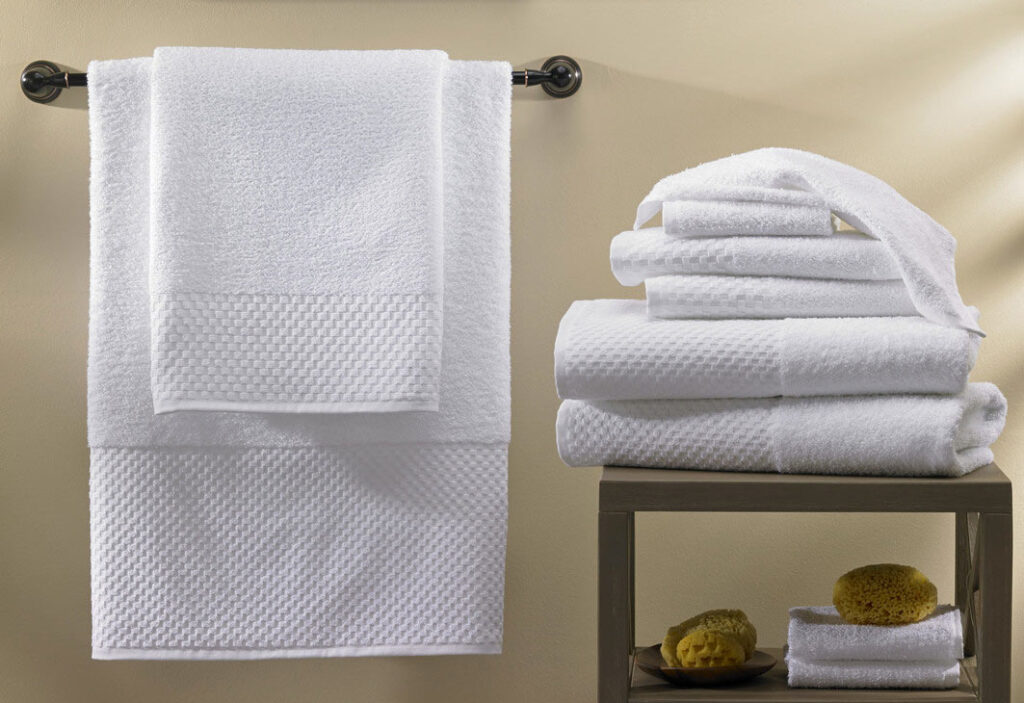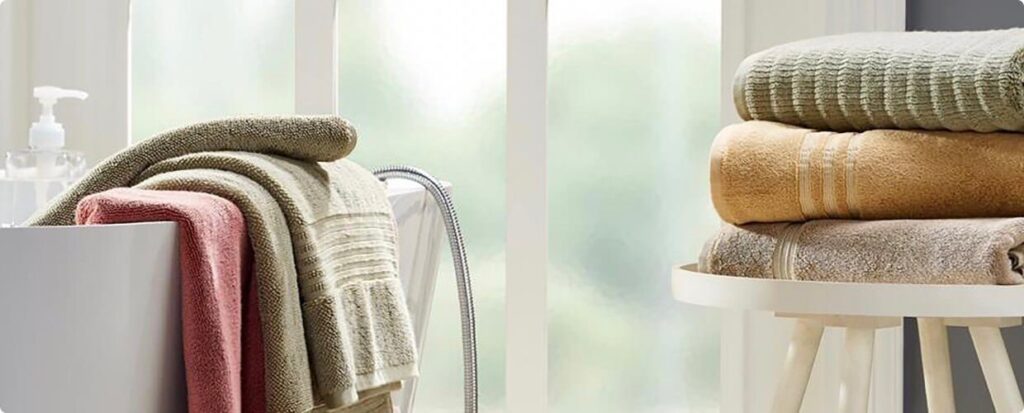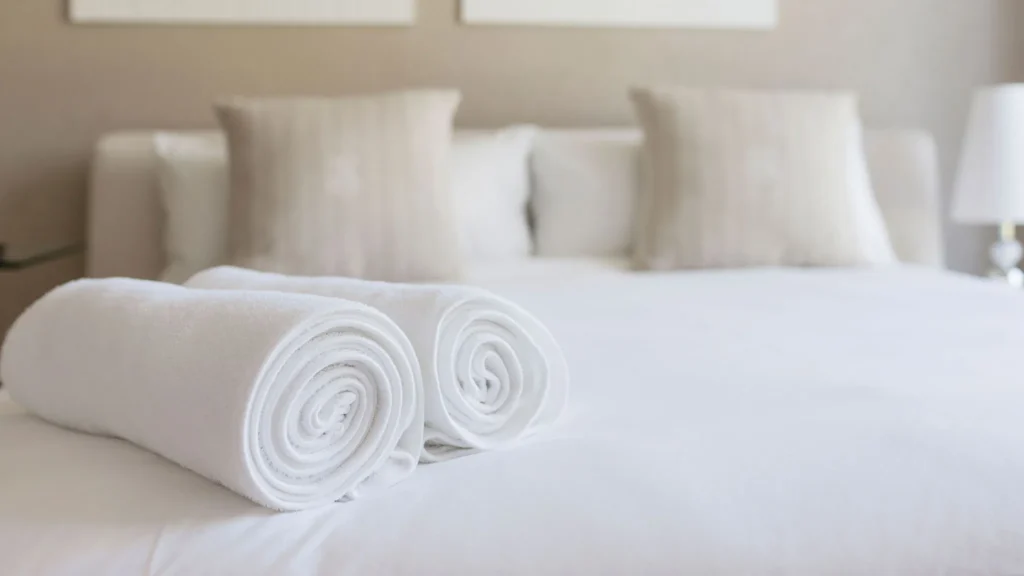There are many factors that are responsible for the absorbency of a towel. First, the material from which it has been made; second, the technique of making a towel; and last, how you treat your towels.
Table of Contents

A few factors on which the absorbency of a towel depends are:
Material
The absorbency of a towel is greatly influenced by the kind of material that was utilized to produce it. Natural textiles with a high absorption capacity include cotton and bamboo. Because of its superior absorption capacity, cotton in particular is a widely used material for towels. Towels frequently employ terry cloth, a kind of looped or pile cotton fabric that increases the surface area available for absorbing water.
Density
Absorbent towels often have a higher fiber density. Because there is more room between the fibers to contain liquid, towels with a higher thread count or larger pile may store more water.
Weave or structure
The absorbency of a towel is also influenced by its weave or construction. Terry cloth and other towels with loops or heaps are great at absorbing water because they form pockets that hold moisture. Additionally, the absorbent is waffle weave, which has a textured design.
Fabric treatment
To improve their absorbency, some towels are given unique coatings or finishes. To make towels more absorbent, for instance, they could be chemically treated or pre-washed. The efficacy of the towel may diminish over time as a result of these treatments wearing off.
Size and thickness
Because they have more surface area and room to hold moisture, larger, thicker towels are able to absorb more water.
Cleaning and maintenance
To keep towels as absorbent as possible, they must be cleaned and cared for properly. If a towel gathers residue from fabric softeners, detergents, or hard water minerals over time, it may lose its absorbency. Towels can be kept more absorbent by washing them with vinegar or baking soda and avoiding fabric softeners.
Wear and age
Towels may lose some of their absorbency of a towel with time and use. With time, the fibers may degrade and lose some of their capacity to efficiently capture and retain water.
How can I make my towels more water-absorbent?
With the passage of time and more and more usage, towels lose their power to absorb water due to the accumulation of detergent, the deposition of minerals through hard water, and fabric softeners.

Surprisingly, there are ways to restore the lost absorbency of a towel with some easy steps.
Wash Towels Separately
Make sure to wash your towels apart from other laundry, particularly lint-producing garments. Towels that collect lint might become less absorbent.
Reduce the Amount of Detergent You Use
Too much detergent might cause residue to accumulate on your towels, decreasing their absorbency. Consider using a gentle detergent and use less detergent than is advised.
Steer clear of fabric softeners
They could leave a coating on towels that reduces their absorbency. While washing towels, omit the fabric softener.
Warm Water and Vinegar
Take a cup of white vinegar and use it to wash your towels every now and then. This aids in removing mineral accumulation and soap residue. To be sure the vinegar is gone, do one more rinse cycle.
Baking soda
Another option is to mix half a cup of baking soda into your towel wash. It can aid in decomposing residue and reviving the towels.
Don’t Overload
Don’t put too much load on the washing machine. If you are overloaded, it may be difficult to give your towels a deep wash.
Dry Linen in the Sun
Towels can be naturally freshened and disinfected by sunlight. Towels should always be hung outside in the sun to dry.
Steer Clear of Excessive Heat
When drying your towels, stay away from using excessive heat settings. Extreme heat can weaken the fibers and decrease their absorbency. Select low or medium-heat settings.
Use Tennis or Dryer Balls
You can de-stiffen and fluff up towels by placing tennis or dryer balls inside the dryer.
Replace Old Towels
It may be time to buy new towels if yours are quite old and have lost their absorbency in spite of the aforementioned remedies. Older towels may have worn-out fibers because they have a limited lifespan.
Select High-Quality Towels
When purchasing new towels, choose towels made of Egyptian or Turkish cotton, which are renowned for their absorbency.
Why do new towels not absorb water like old ones?
The hidden heroes of absorbency, towel fibers, are essential. These fibers are at their most fluffy when towels are brand new. Nonetheless, they are inherently hydrophobic, which means they dislike water. Their capacity to wick water is reduced by this hydrophobicity. These fibers are washed and used repeatedly over time, fraying them and opening up lots of microscopic holes for water to seep through, thus increasing the towel’s hydrophilicity.

Lint is an additional consideration. Fresh towels give up lint, which creates an undesired barrier that gets in the way of absorption between the towel and your skin. However, old towels have lost a lot of their lint, which allows them to come into close contact with your skin and increase drying effectiveness.
Furthermore, residues that impede absorption may be left behind by the fabric softeners and detergents used when washing new towels. On the other hand, well-seasoned towels have largely overcome these obstacles.
Why do towels in hotels absorb the water and dry you so much better than towels at home?

It involves science and painstaking attention to detail in addition to imagination.
- The production method of the hotel’s luxurious towels is one of its best-kept secrets.
- They are painstakingly made from long-staple cotton of the highest caliber, which is known for its exceptional absorbency.
- Because of their longer length, these fibers may weave into a denser structure, which improves water retention.
- The meticulous processing of hotel towels lowers any remaining oils and waxes, making the fabric more absorbent of water molecules.
- They go through several washing cycles to make sure all dirt and lint are removed.
- Hotel towels are intentionally enlarged, providing a greater surface area for the effective absorption of water.
- Their painstaking construction, which frequently includes a lovely dobby border, helps to drain moisture away from your skin in addition to adding a touch of elegance.
- Additionally, hotel washing procedures are more advanced, utilizing industrial-grade equipment, accurate detergent dosages, and thorough rinsing to maintain dependably soft and absorbent towels.
want to buy a towel, click here